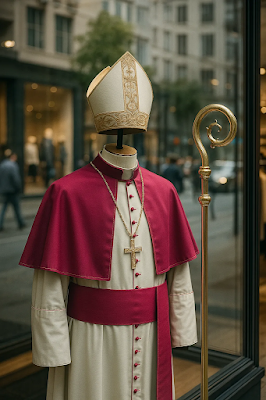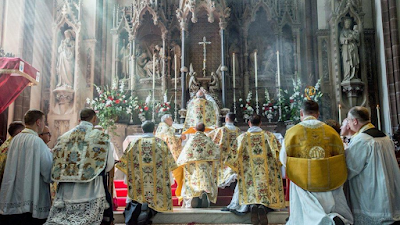To comment please open your gmail account or use my email address FB Messenger or X. (Protestants, no rants are posted on this page except to elucidate Catholic doctrine.)
 |
Leo XIV’s Vision of the Church Without Teeth |
Do traditional Catholics get the feeling they're being wooed? That the first 'Boomer Pope', Leo XIV, is chatting them up? He's looking and sounding so trad (wearing the mozetta, singing the Regina Caeli and the Pater Noster). But how's he acting? Yes, he did lead a Corpus Christi Procession through Rome - but one swallow does not a summer make.
His promotion of the bully +Arthur Roche and assorted material heretics to powerful positions proclaims him as the personalised 'Spirit of Vatican II' - even to exhibiting its chronic effeminacy by tears appealing to the feminised, not to say emasculated, post-Vat II Novus Ordo, Synodal Church. As a Boomer +Leo was brought up with a Mass that had been emptied of all that Protestants might find objectionable, inculcating an idea of 'unity' which eschews any reference the deposit of faith.
But sooner or later +Leo must address these burning questions:
- the Mass of all time (TLM), brutally treated by Jorge Bergoglio and cavalierly implemented by +Roche riding roughshod over the world's bishops https://www.pillarcatholic.com/p/roches-gamble-and-the-vatican-law-of-power
- the Consecration of Russia: it's all very well to exhort the faithful to pray for peace, but peace is in the hands of the pontiff and his bishops
- publication of the full text of the Third Secret of Fatima
- permission for the Society of St Pius X (SSPX) to consecrate new bishops for its nearly one million adherents worldwide.
His sincerity is not to be doubted. But what he sincerely intends appears to be the practice of Vatican II's original, fatally flawed vision rather than restoration of the Catholic Faith.
Cardinal Joseph Zen lets Pope Leo know where he stands on the TLM
In a span of forty-eight hours, Leo XIV addressed bishops, seminarians, priests, Eastern Church donors, drug rehab alumni, and synod bureaucrats. If you want to understand the post-conciliar Church’s ideology in full, its spiritual posture, its rhetorical evasions, and its strategic silences, you couldn’t ask for a better window.
On paper, the theme is hope. In practice, it’s accommodation with every force that drains the Church of life.
I. The Pastoral Bishop as Therapist
Leo’s Jubilee of Bishops meditation reaffirms the now-familiar portrait of the bishop not as a successor of the Apostles defending the deposit of faith, but as a “visible principle of unity” tasked with facilitating dialogue, managing “diverse gifts,” and exercising “pastoral prudence” by overseeing synodality.
You might assume “unity” here means doctrinal cohesion. It doesn’t. It means structural harmony: communion without confession. The bishop, we are told, must embrace “dialogue as a style and method.”
He must “cherish traditions” while also “promoting new directions and initiatives.” The theological virtues, faith, hope, and charity, are redefined through a pastoral lens, not as supernatural habits ordered to truth and salvation, but as tools for emotional uplift and social healing.
 |
| Any good Proddy or devout Muslim would agree |
Chastity and continence make a brief cameo: Leo XIV insists they reflect the “authentic image of the Church.” But the real pastoral action comes through “dialogue,” “participatory bodies,” and “fraternal love” extended to every living bishop in sight. The bishop, we are assured, should even be “open and welcoming” in his home. Whatever that means.
The entire vision reduces episcopal governance to a kind of chaplaincy: the bishop as emotional support mammal.
II. The Anonymous Touch of Faith
In his General Audience, Leo explores the Gospel account of the bleeding woman and Jairus’ daughter: two miracles traditionally interpreted as signs of Christ’s divinity and salvific power. But in Leo’s hands, the story becomes
Saint Augustine’s line, “the crowd jostles, faith touches,” is invoked, but not to call sinners to conversion. Instead, it validates the felt experience of “being labeled,” “kept hidden,” or made to wear “a robe not your own.”
And that’s the core problem: Leo XIV uses the language of Scripture but flattens its theology into a kind of affective solidarity. Jesus doesn’t confront sin, death, or the devil here, He offers “spiritual nourishment” and “closeness.” The bleeding stops, the child awakens, and the main lesson is… “do we know how to nourish our children spiritually?”
The only spiritual death Leo warns against is “the death of the soul,” but he never says what causes it or how to prevent it.
III. Formation Without Foundations
Addressing seminarians from Triveneto, Leo offers some helpful advice on trust, prayer, and avoiding isolation. He even quotes St. Augustine and Robert Hugh Benson. But again, what’s missing is striking: no admonition to hold fast to the Church’s unchanging teaching, no warning about the dangers of modernism or heresy, and not a word about the liturgy.
 |
| https://www.youtube.com/watch?v=7u_ueJfk2BU |
Instead, the seminarians are told to be “protagonists” in formation (but not “soloists”), to trust their formators, and to maintain “friendship with Jesus,” the central phrase of the entire talk. And what is this friendship? According to Leo (and Francis before him), it’s a feeling of being accompanied and understood. The seminarian’s chief task isn’t to become an alter Christus, but a companionable peer.
This relational formation tracks exactly with the goals of the Dicastery for the Clergy, who gathered the next day for the “Priests Who Are Happy” convocation. Priests are called “friends,” not soldiers or servants. Celibacy isn’t an imitation of Christ crucified, but a “sign of friendship.” Leo calls for “caring preparation of formators” to help produce men who are good at “listening, praying, and serving together.”
Doctrinal precision? Liturgical integrity? Defense of the faith? Nowhere to be found.
IV. The Synodal Steamroller
Leo’s brief remarks to the Synod Council provide the clearest summary of how this all fits together. Synodality, he says, is “a style,” not a doctrine. But it has become the governing principle of ecclesial life. Borrowing from Paul VI and perfected under Francis, synodality now acts as the Church’s ecclesiological skeleton: not a means to truth, but a method of process.
This is why, across his speeches, Leo XIV doesn’t emphasize proclamation, conversion, or doctrinal clarity. His vision of the Church is administrative and therapeutic instead of militant and apostolic. The bishop listens. The priest accompanies. The faithful journey together.
And synodality ensures that no one raises their voice too loudly about anything.
V. War and the East: Words Without Consequences
Leo’s address to ROACO (the Reunion of Aid Agencies for the Oriental Churches) offers his most impassioned rhetoric; denouncing wars in Gaza and Ukraine, criticizing “merchants of death,” and calling the Christian East a “light” in a darkened world.
But like all modern Vatican statements on war, the language is reactive and disconnected from doctrinal judgment. There is no moral condemnation of aggressors, no defense of just war principles, no acknowledgment that error and heresy often fuel these conflicts.
Most strikingly, he calls for more exposure to Eastern Catholic traditions in seminaries, not to restore tradition in the Latin Rite, but to help the West breathe with its “second lung.” But this is pure performance. The same Vatican that crushes Latin liturgical tradition turns to the East not out of love, but as a decoy.
 |
| Pope Leo leads a Corpus Christi Procession - wooing the Trads? |
VI. Dignity Without Repentance
In perhaps the most bizarre speech of the week, Leo addressed recovering addicts and social workers for the UN’s International Day Against Drug Abuse. There were touching moments, to be sure, Leo emphasized the freedom found in recovery and the dangers of marginalization.
But again, no mention of sin. No call to repentance. No exhortation to live in grace or avoid the near occasions of evil. Addiction is not treated as a spiritual bondage to be exorcised, but as a social illness to be treated through encounter, inclusion, and the dismantling of unjust structures.
The language of the speech could’ve come from a secular humanist. The only references to Christ are abstract: Jesus who says “peace be with you,” Jesus who enters “locked rooms,” Jesus who breathes on you through others.
It is the Gospel as therapeutic support group.
 |
| The TLM appeals to young people - but not to the post-conciliar Vatican |
Conclusion:
Across these addresses, a single pattern emerges: Leo XIV affirms every spiritual longing while carefully avoiding the demands that give those longings shape.
Priests are to be friends. Bishops are to be facilitators. Faith is an emotional movement toward inclusion. Sin, when acknowledged at all, is reframed as social exclusion or “the absence of God.” The Eucharist is barely mentioned. Christ’s kingship is replaced with Christ’s companionship.
There is no doctrinal muscle left in this vision of the Church. Only the shepherd’s costume remains: soft fleece and a smile, worn over a hollow frame.https://bigmodernism.substack.com/p/the-shepherds-costume-leo-xivs-vision










